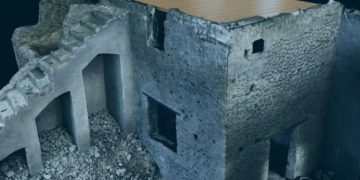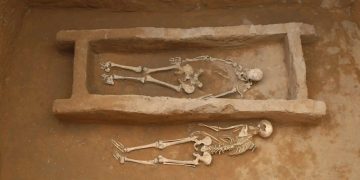A VAMPIRE tomb has been unearthed with a sickle around its neck to prevent the “monster” from ever rising.
The tomb was discovered by archaeologists deep beneath a church in northern Poland after they began conservation work on the church.

Skeletal remains were discovered with a sickle around it’s neck to prevent the suspected vampire from rising from the dead[/caption]

It was the first time a vampire tomb of this kind was discovered inside a church[/caption]

The church was undergoing conservation work when the tomb was found[/caption]
The remains were discovered with a sickle around its neck – thought to behead the “vampire” if it ever tried to rise from the dead.
Archaeologists working at the Annunciation of the Blessed Virgin Mary in Pączewo say the vampire tomb is the first of its kind to be discovered inside a church.
Two other skeletons were buried nearby.
According to anthropologist Dr Justyna Karkus, the remains were that of a 50-year-old male with numerous healed injuries to his skull.
She said: “The skull with numerous injuries indicates that the man had many deep scars on his face during his life.
“During one of the blows, he also lost some of his teeth.
“He looked different than average people. And that can be scary.
“In the 17th century, this man was accused of vampirism.”
She added the discovery of a vampire burial in a church is especially rare, saying: “No one expects to find a vampire in a church.”
While it’s the first case of a “vampire” being buried inside a church, it is not the first time archaeologists have discovered graves with sickles on the neck.
Similar graves dating from the 17th century were discovered in Pomerania, Pien, and Chojnice in Poland, where folk legends of alleged vampire attacks were widespread.
Local folklore from the time shows the term referred to people who would come back from the dead to torture the living.
To prevent vampires or “restless souls” from returning to the land of the living, various procedures were used to keep the remains buried 6ft underground.
This included sickles being placed around the neck, binding their hands and feet, bodies buried facing down and large stones placed on the graves.
An earlier “vampire” child grave was recently discovered in another part of Poland.
The site was dug up in Koszalin, northwest Poland, with two child skeletons uncovered in the earth.
Archaeologists found the so-called “revenant” graves with the children buried in special pits without coffins.
One of the scientists said the site bore signs of an “anti-vampire” burial, in a type of grave found all across Europe.
They were designed to stop the dead from rising – such as by placing large stones on the legs of the person being buried.
The body might also have been pierced with a lance to fix it permanently to the ground.
The discovery was revealed by the Lublin Provincial Conservator of Monuments on Facebook.
One conservator said: “Burying with the face to the ground, cutting off the head or pressing the body with a stone are among the methods used to prevent a person believed to be a demonic being from leaving the grave.”
The skeletons are set to be analysed properly as archaeologists dig deeper into the history of their burials.
A similar discovery was made in September last year when a graveyard of “child vampires” were excavated in the Polish village of Pien.
Records of myths about the dead date back as far as the 11th century in Central and Eastern Europe.
Many believe that Vlad III, better known as “Vlad the Impaler” was the inspiration behind the folklore legend after stories about his cruel acts began to circulate.
According to legend, Vlad Drăculea enjoyed dining amidst his dying victims and dipping his bread in their blood.
The vampire myth was further popularised by Bram Stoker’s “Dracula” which featured famed vampire hunter – Abraham Van Helsing.
Are vampires real? History of the legend
WITH sharp fangs and a penchant for blood, vampires have become the stuff of legends.
All you need to do is turn the TV on to Buffy, Angel, Supernatural and True Blood or flick through an Anne Rice novel or Bram Stoker’s novel to see that Vampires continue to have a hold on society.
Folklore has portrayed vampires as undead beings who feast on the blood of innocent people.
They’re notoriously allergic to daylight, and can be repelled with garlic and a crucifix.
There are almost as many different characteristics of vampires as there are vampire legends.
They typically drain their victim’s blood using their sharp fangs, killing them and turning them into vampires.
According to popular novel “Dracula”, vampires cannot travel on water and must sleep in soil from their home land.
Meanwhile, in Anne Rice’s “Interview with a Vampire”, vampires aren’t afraid of the crucifix.
However, in other popular myths and pop culture, vampires are afraid of holy water, crucifixes and garlic.
While it is steeped in folklore, the legends of blood-sucking vampires could have been based on real people, experts have revealed.
A team of scientists at Boston Children’s Hospital believe a rare genetic mutation could have caused some people to display traits of “vampires”, leading to the fictitious characters we know about today.
The condition erythropoietic protoporphyria (EPP), is a blood disorder that affects kids, causing their skin to become very sensitive to light.
The condition affects the body’s ability to make heme, which helps make haemoglobin – part of our blood that helps carry oxygen.

Two other skeletons were also found buried in the church[/caption]



























